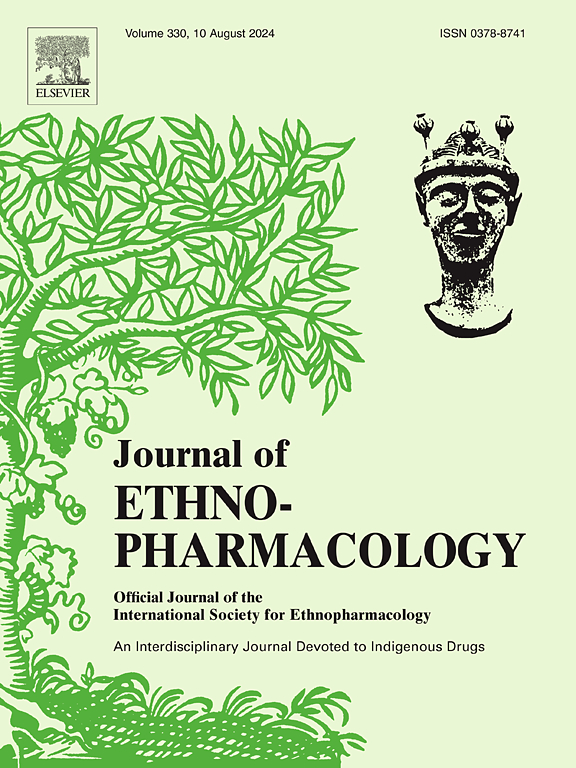Toona sinensis fruit polyphenols alleviate cerebral ischemia-reperfusion injury in rats by inhibiting MAPK signaling pathways and NLRP3 inflammasome/pyroptosis
IF 4.8
2区 医学
Q1 CHEMISTRY, MEDICINAL
引用次数: 0
Abstract
Ethnopharmacological relevance
Toona sinensis fruit polyphenols (TSFP) are polyphenols that have been separated and extracted from mature Toona sinensis fruits. TSFP anti-inflammatory and neuroprotective properties have demonstrated promise. However, the underlying mechanisms require more elucidation.
Study aim
The aim of this study is to investigate the mechanisms by which TSFP alleviates cerebral ischemia-reperfusion injury (CIRI) through the mitogen-activated protein kinase (MAPK) and NOD-,LRR- and pyrin domain-containing protein 3 (NLRP3) inflammasome pathways on middle cerebral artery occlusion/reperfusion (MCAO/R) rats.
Materials and methods
The TSFP neuroprotective effect was evaluated using transmission electron microscope (TEM), 2,3,5-triphenyltetrazolium chloride (TTC), neurological function, and hematoxylin-eosin (H&E) staining. An enzyme-linked immunosorbent assay (ELISA) and immunofluorescence were used to measure the TSFP influence on inflammation. In addition, a Western blot assay was performed to assess the NLRP3 inflammasome and MAPK pathway proteins expressions in the prefrontal cortex (PFC) and hippocampus, and double immunofluorescence methods were used to identify gasdermin D (GSDMD) secretion in neurons.
Results
The TSFP group in the MCAO/R model had improved levels of cerebral infarction and brain pathological damage. The TEM demonstrated that TSFP ameliorated ischemia-induced neuronal pyroptosis, and there was a significant decrease in the expressions of NLRP3, the apoptosis-associated speck-like protein containing Caspase recruitment domain (ASC), cysteine aspartate-specific protease-1 (caspase-1), and GSDMD in the TSFP groups. TSFP reduced the phosphorylation of p38 mitogen-activated protein kinase (p38) and extracellular signal-regulated kinase 1/2 (ERK1/2), promoted the phosphorylation of extracellular signal-regulated kinase 5 (ERK5), and reduced the phosphorylation of c-Jun amino terminal kinase (JNK) in the hippocampus. The results also revealed that TSFP significantly lowered the interleukin-1β (IL-1β) and interleukin-1β (IL-18) expressions and attenuated glial cell activation caused by ischemia in the PFC and hippocampus DG areas.
Conclusion
This study provided evidence for the efficacy of TSFP in the treatment of CIRI, with potential mechanisms that involved the control of the MAPK signaling pathways and NLRP3 inflammasome/pyroptosis, which highlights the potential benefits of TSFP in the treatment of CIRI.

香椿果实多酚通过抑制MAPK信号通路和NLRP3炎症小体/焦亡,减轻大鼠脑缺血再灌注损伤。
民族药理学相关性:香椿果实多酚(TSFP)是从成熟香椿果实中分离提取的多酚类物质。TSFP具有抗炎和神经保护的特性。然而,潜在的机制需要更多的阐明。研究目的:本研究旨在探讨TSFP通过丝裂原活化蛋白激酶(MAPK)和NOD-、LRR-和pyrin结构域蛋白3 (NLRP3)炎症小体通路减轻大脑中动脉闭塞/再灌注(MCAO/R)大鼠脑缺血再灌注损伤(CIRI)的机制。材料与方法:采用透射电镜(TEM)、2,3,5-三苯四唑氯(TTC)、神经功能、苏木精-伊红(H&E)染色评价TSFP的神经保护作用。采用酶联免疫吸附法(ELISA)和免疫荧光法检测TSFP对炎症的影响。western blot检测大鼠前额皮质(PFC)和海马NLRP3炎性体和MAPK通路蛋白表达,双免疫荧光法检测神经元中气皮蛋白D (GSDMD)分泌情况。结果:在MCAO/R模型中,TSFP组脑梗死程度和脑病理损伤程度均有所改善。透射电镜显示,TSFP改善了缺血诱导的神经元凋亡,TSFP组NLRP3、凋亡相关斑点样蛋白(含Caspase募集结构域(ASC))、半胱氨酸天冬氨酸特异性蛋白酶-1 (Caspase -1)和GSDMD的表达显著降低。TSFP降低了p38丝裂原活化蛋白激酶(p38)和细胞外信号调节激酶1/2 (ERK1/2)的磷酸化,促进了细胞外信号调节激酶5 (ERK5)的磷酸化,降低了海马c-Jun氨基末端激酶(JNK)的磷酸化。结果还显示,TSFP显著降低PFC和海马DG区缺血引起的胶质细胞活化,显著降低IL-1β (IL-1β)和IL-18的表达。结论:本研究为TSFP治疗CIRI的疗效提供了证据,其潜在机制可能涉及控制MAPK信号通路和NLRP3炎症小体/焦亡,这凸显了TSFP治疗CIRI的潜在益处。
本文章由计算机程序翻译,如有差异,请以英文原文为准。
求助全文
约1分钟内获得全文
求助全文
来源期刊

Journal of ethnopharmacology
医学-全科医学与补充医学
CiteScore
10.30
自引率
5.60%
发文量
967
审稿时长
77 days
期刊介绍:
The Journal of Ethnopharmacology is dedicated to the exchange of information and understandings about people''s use of plants, fungi, animals, microorganisms and minerals and their biological and pharmacological effects based on the principles established through international conventions. Early people confronted with illness and disease, discovered a wealth of useful therapeutic agents in the plant and animal kingdoms. The empirical knowledge of these medicinal substances and their toxic potential was passed on by oral tradition and sometimes recorded in herbals and other texts on materia medica. Many valuable drugs of today (e.g., atropine, ephedrine, tubocurarine, digoxin, reserpine) came into use through the study of indigenous remedies. Chemists continue to use plant-derived drugs (e.g., morphine, taxol, physostigmine, quinidine, emetine) as prototypes in their attempts to develop more effective and less toxic medicinals.
 求助内容:
求助内容: 应助结果提醒方式:
应助结果提醒方式:


